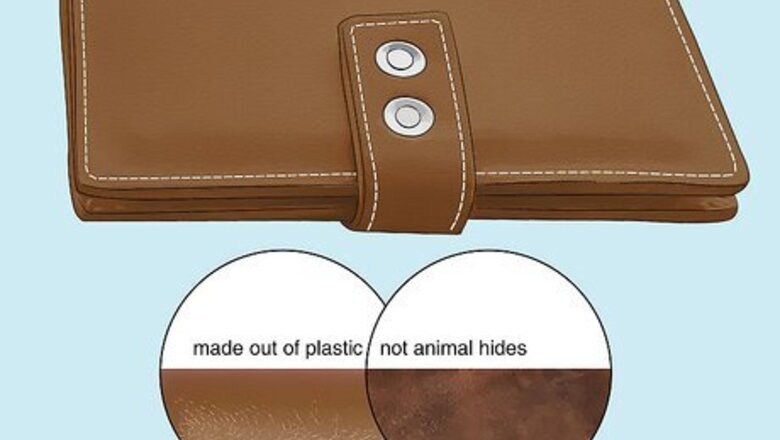
views
What is PU leather?

PU leather is an artificial leather made out of polyurethane. PU leather, which stands for polyurethane leather, is a type of fake leather made out of a special kind of plastic called thermoplastic polymers. Because PU leather is made out of plastic and not animal hides, like genuine leather, it is vegan. PU leather is also called faux leather, synthetic leather, vegan leather, and pleather. PU leather is used in a wide variety of products, including upholstery, furniture, clothes, shoes, and accessories.

There are different types of PU leather, like bonded and bicast leather. PU leather is processed and formed in different ways to create separate kinds of faux leather, including bonded or reconstituted leather, split leather, bicast leather, and corrected grain leather. These faux leathers are typically made with varying amounts of plastic and genuine leather (which contains animal products). While PU leather can be made with genuine leather, it is still considered a fake or faux leather because it contains plastic. Only leather made with 100% animal hide is considered genuine leather. Note: Not all types of PU leather are vegan, as they can contain some genuine leather, or animal-derived products. Check the label on the item you’re looking at to make sure it’s 100% plastic.
Pros and Cons of PU Leather

Pros: PU leather is inexpensive, long-lasting, versatile, and vegan. PU leather is typically less expensive to produce than real leather, which makes it inexpensive to buy. It also stands up to wear and tear, is water resistant, and can last for several years. Because it’s made of plastic, it comes in a wide variety of colors, patterns, and animal prints. This also means that it’s vegan and cruelty-free. Overall, PU leather is a great alternative to real leather, especially if you’re vegan, on a budget, or want a highly customizable leather.
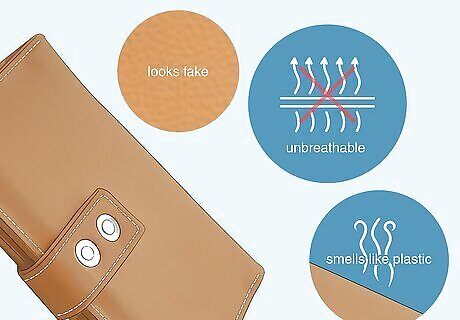
Cons: PU leather can look fake, be unbreathable, and smell like plastic. While PU leather is made to mimic genuine leather, it doesn’t have the same look and feel as the real deal. It is also less porous and breathable than genuine leather, so it can be uncomfortable to sit on and wear on hot days. Because it’s a synthetic plastic, PU leather can sometimes smell chemically or plasticky, too. The plastic, chemical smell of PU leather typically wears off with time and use. Or, spray your PU leather with a fabric deodorizer spray.
Differences Between PU Leather and Genuine Leather
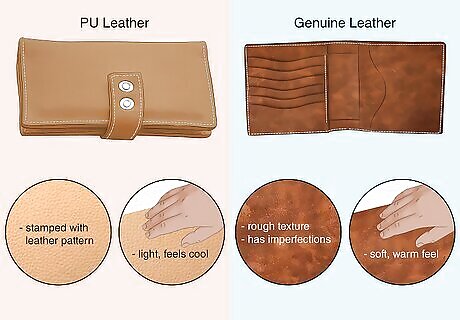
Appearance Genuine leather is made out of animal hides, which gives it a distinct grain pattern that is rough and full of imperfections. With time, it also develops a desirable patina, or shine. PU leather is stamped with a leather pattern, giving it a more uniform grain that can look super smooth and fake. Genuine leather typically has a soft, warm feel and weight to it while PU leather feels cool, plasticky, and light. Looking for imperfections in leather is typically the best way to tell if the leather is genuine or fake. Real leather also has an earthy, woodsy smell while faux leather is more plastic-like.
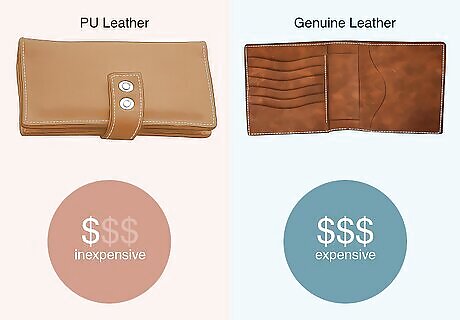
Price In general, PU leather is less expensive to manufacture and buy than genuine leather. Plastic is more readily available and easily produced than animal hides. PU leather is also easier to make, as it simply involves pouring, pressing, and embossing plastic polymers. Processing leather takes longer and requires the skills of a trained craftsman. For instance, a faux leather bag might cost $15 to $30 while a genuine leather bag costs upwards of $100.

Durability Genuine leather is typically more resistant to wear and tear than PU leather. When properly cared for, genuine leather can last a lifetime and is less prone to cracking and peeling. While PU leather is often more resistant to scratches, it typically cracks over time. So, it might only last for 1-2 years with frequent use. Proper care and cleaning can prevent PU leather from cracking and peeling. We’ll explain how to take care of your PU leather in the sections below! Because genuine leather develops a patina over time, it can actually look better as you use it. While real leather is typically more expensive than PU leather, it can be a better investment because it lasts longer and is more durable.

Breathability Genuine leather has more pores than PU leather, which usually makes it more breathable. Air doesn’t circulate as well through PU leather, which means it can be more sticky, sweaty, and uncomfortable to wear or sit on than real leather.

Maintenance PU leather is usually easier to clean and care for than genuine leather because it's made out of plastic. You clean most PU leather with a damp cloth or soapy water and you only need to condition it semi-regularly. Genuine leather is more sensitive and delicate, so it requires special leather cleaners and conditioners to stay in good condition.
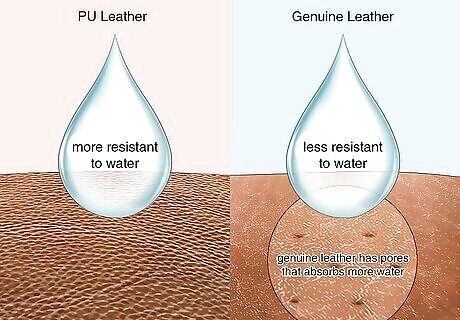
Water resistance While neither PU leather nor genuine leather is waterproof, PU leather is more water resistant than real leather. This is because PU leather has fewer pores and absorbs less water. This also makes PU leather more resistant to stains than genuine leather, which easily absorbs water and liquids. If you want your PU leather or genuine leather to be waterproof, simply spray it with a waterproofing spray.
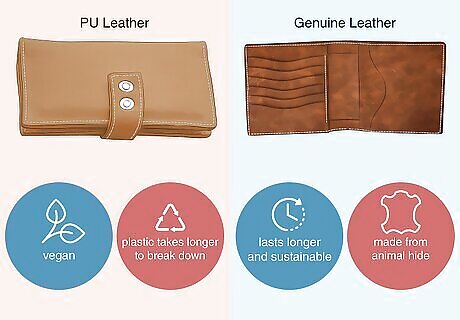
Environmental impact When it comes to PU leather and genuine leather, there’s a tradeoff between sustainability and using animal products. While PU leather is vegan, it’s made with plastic, which is less environmentally friendly to produce and takes longer to break down. Genuine leather is considered more sustainable because it lasts longer, but it is made out of animal hides. Shopping for secondhand PU leather or genuine leather items is a great way to offset any environmental concerns you have. For instance, search for items at thrift shops and consignment stores or use apps like Depop and Poshmark.
Differences Between PU Leather and other Faux Leathers
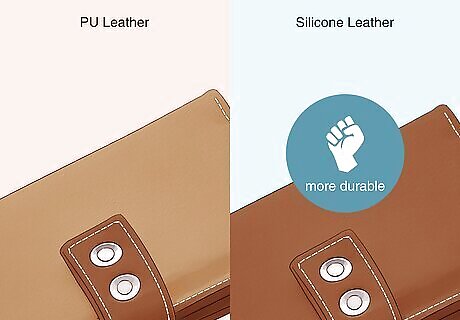
Silicone leather is more durable than PU leather. Silicone leather is a type of faux leather that is made out of silicone, or a rubber-like material. It is generally thicker than PU leather and more resistant to damage (such as tears, wrinkling, and cracking), light, and cold. On the other hand, PU leather is typically lighter and more flexible than silicone leather. Silicone is a naturally occurring material, so it is generally more sustainable and environmentally friendly to produce than PU leather. PU leather is mostly used for clothing and upholstery, while silicone leather is used as a leather alternative in almost every industry, from fashion to cars.
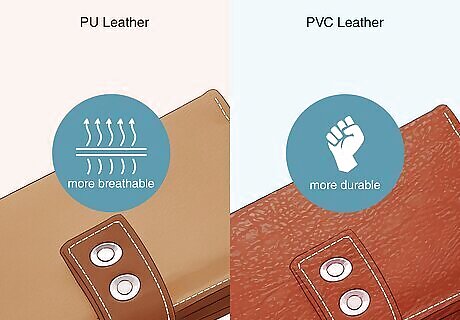
PVC leather is more durable while PU leather is more breathable. PVC leather, or polyvinyl chloride leather, is another type of faux leather that’s made out of plastic. Compared to PU leather, PVC leather is typically more damage-resistant, thicker, and less prone to stains. PU leather might be less durable, but it is generally thinner, more flexible, and more breathable. In general, PVC leather is best for items that need to be stain-resistant, like furniture and upholstery. PU leather’s flexibility and breathability make it best for clothes and accessories.
Cleaning and Caring for PU Leather

Clean dirt and stains with warm water and mild dish soap. Wipe the PU leather down with a dry microfiber cloth to remove dust and any loose debris. Then, fill a bowl with warm water and a few drops of dish soap. Dampen a microfiber cloth with the soapy water and wipe the leather. Then, remove any soapy residue with a cloth damped with just water. Dry the leather with a clean microfiber cloth after cleaning it to prevent water damage and cracks from forming. These cleaning instructions work for all types of PU leather items, including clothes, shoes, and upholstery. Note: Spot test the soapy water on an inconspicuous part of the leather to ensure it doesn’t stain it. Alternatively, clean your PU leather with faux leather cleaner. To wash faux leather clothes, like a leather jacket, check the garment’s care instructions. Most items are safe to wash on a delicate cycle with mild laundry detergent.
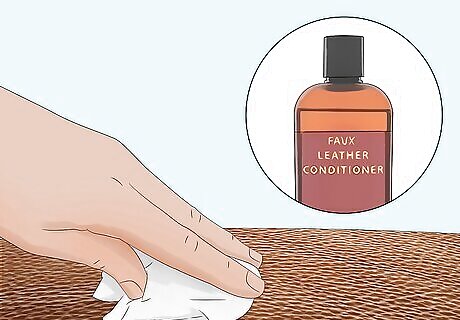
Condition PU leather regularly with a faux leather conditioner. When your PU leather starts to look dull and dry, apply a faux leather conditioner to moisturize it. Simply spray the conditioner onto a microfiber cloth and wipe it into the leather. Conditioning your PU leather also helps protect it against cracking and peeling. Read the conditioner’s instructions to know how often to apply it. Some manufacturers recommend conditioning your leather monthly while others recommend applying it less often.
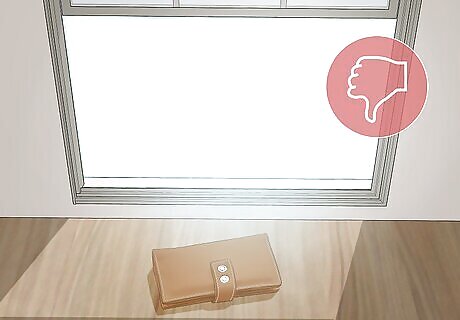
Store PU leather out of the direct sun and in a cool, dry spot. PU leather tends to dry out in the sun, which can cause discoloration, cracking, and peeling. So, keep your PU leather furniture, clothes, and accessories out of the direct sun as much as possible. High heat and moisture can also damage PU leather, so make sure your home stays cool and dry. To further protect your PU leather items from the sun, spray them with a UV protectant spray. If you’re dealing with a lot of humidity in your home, use a dehumidifier to remove moisture in the air and protect your PU leather items.




















Comments
0 comment